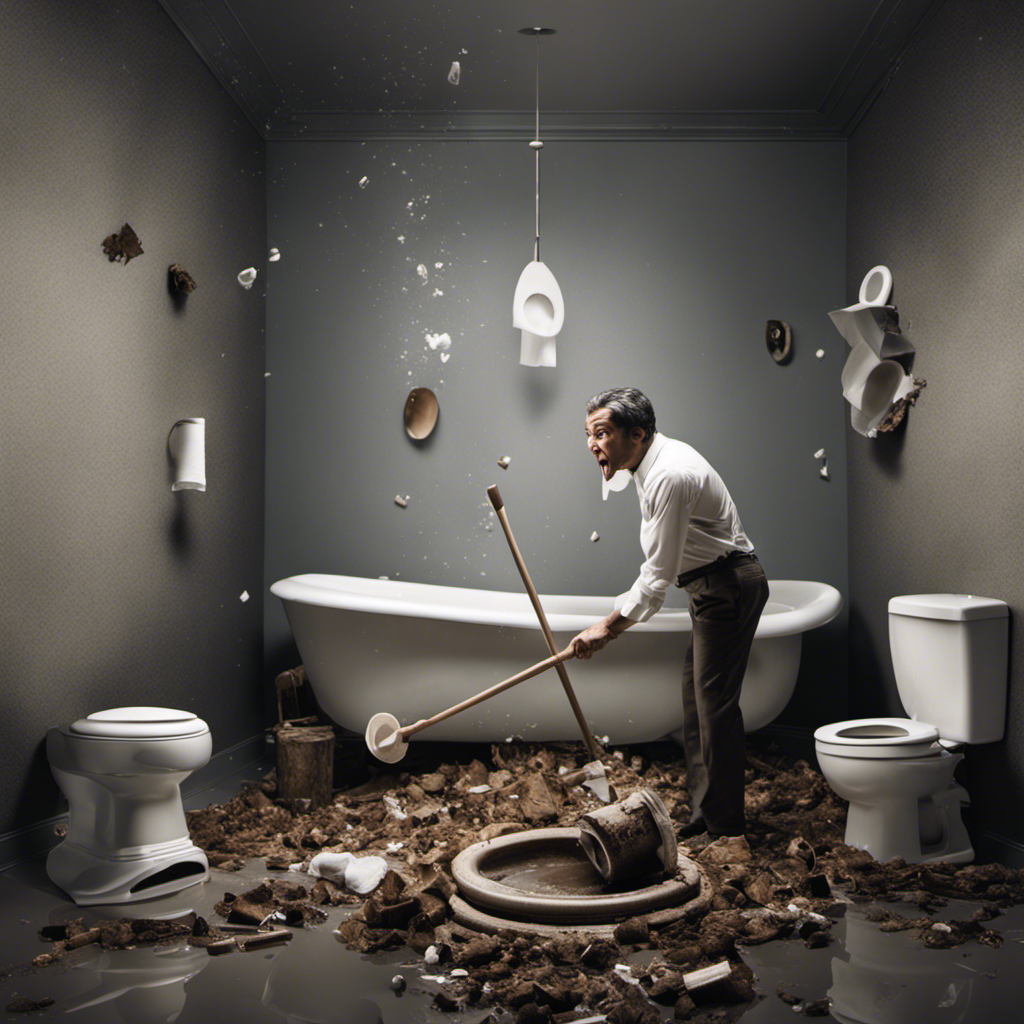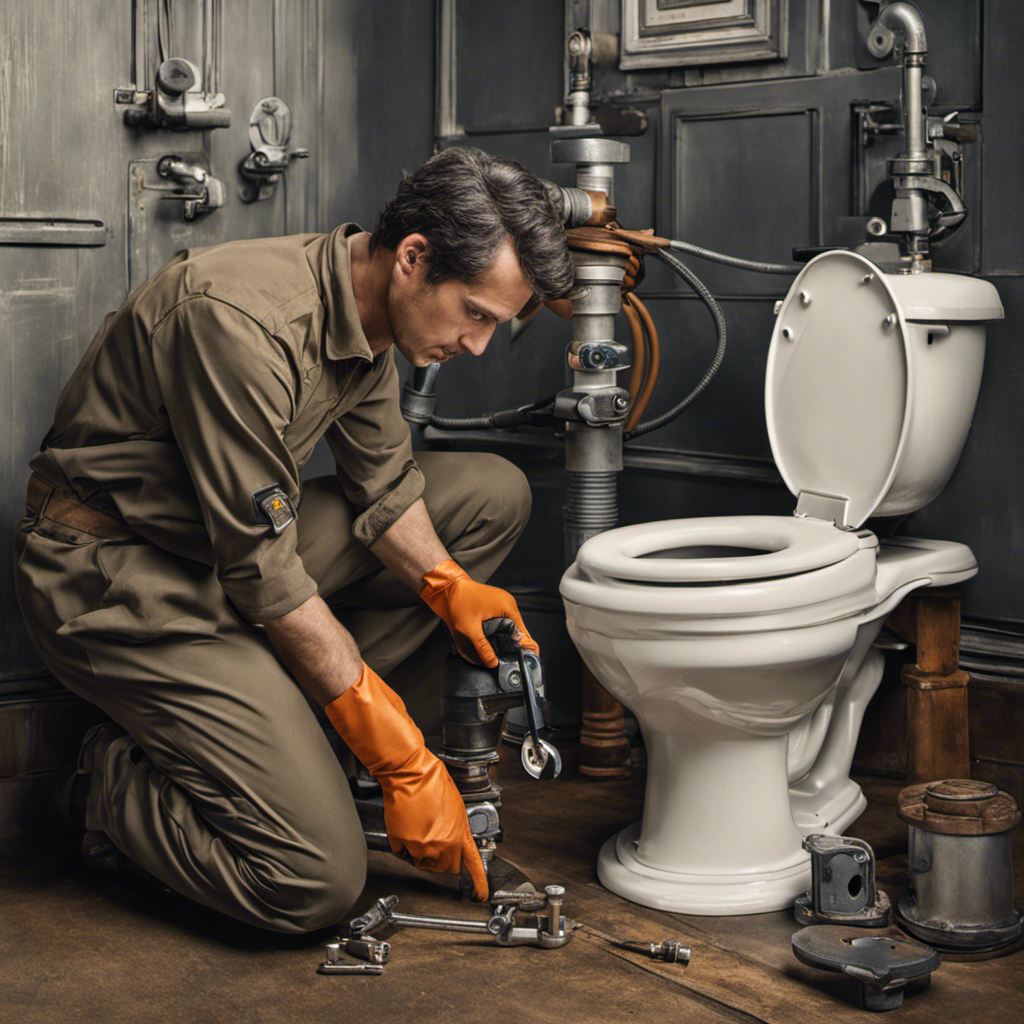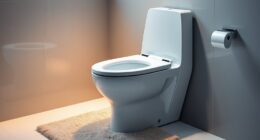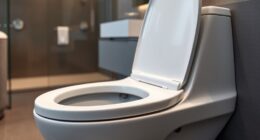When faced with an object trapped in a toilet, it can be a frustrating and messy situation. However, fear not, for there are effective methods available to solve this problem.
This article explores various techniques for removing objects from toilet traps, including using rubber gloves, a wire hook, a toilet plunger, a toilet auger, or a wet/dry vacuum cleaner.
It even discusses the option of removing the toilet bowl itself.
With these methods, one can safely and efficiently retrieve objects from toilet traps.
Key Takeaways
- Wear protective rubber gloves and take safety precautions to avoid contamination and injuries.
- Use manual methods like using hands or a wire hook to remove the object, but exercise caution and seek professional assistance if unsure.
- Plunger method: Ensure a good seal, apply downward pressure, and repeat plunging motion to create a strong vacuum, avoiding excessive force.
- Toilet auger method: Utilize a toilet auger or drain snake for precise and targeted removal, following manufacturer’s instructions to avoid damage.
- Water vacuum method: Use a wet/dry vacuum cleaner with appropriate attachment and suction power to efficiently remove objects without physical contact, being cautious not to push the object further into the drain.
- Removing toilet bowl method: Shut off water supply, disconnect tank, loosen and remove bolts securing the bowl, gently rock the bowl to break the seal, and handle it with care to prevent damage or injury.
Manual Methods
The manual methods involve wearing rubber gloves and using one’s hands or making a wire hook to remove the object from the toilet trap. When attempting to remove an object manually, it is important to take safety precautions.
First, one should ensure that they are wearing protective gloves to prevent any potential contamination. Additionally, it is crucial to handle the object carefully to avoid any injuries.
Common objects found in toilet traps include small toys, toiletries, and even jewelry. These objects can easily get lodged in the trap due to their shape or size. By using manual methods, one can effectively retrieve these objects and restore the proper functioning of the toilet.
However, it is always recommended to exercise caution and, if unsure, seek professional assistance to avoid any further damage.
Plunger Method
Using a toilet plunger is a common method for unclogging a toilet. To properly use a plunger for a clogged toilet, follow these steps:
-
Ensure a good seal between the plunger and the toilet bowl. This will help create suction.
-
Place the plunger over the drain hole, making sure it covers the entire area.
-
Apply downward pressure on the plunger, and then pull up quickly. This motion will create suction and help dislodge the clog.
-
Repeat this plunging motion several times to create a strong vacuum.
-
Be careful not to push the object further down the drain, as plungers can sometimes have this effect.
-
Avoid using excessive force, as it can damage the toilet or cause the water to splash out.
-
Additionally, if there is a risk of the toilet overflowing, it is best to avoid using a plunger.
Remember to exercise caution and use common sense when attempting to unclog a toilet.
Toilet Auger Method
One option for removing an object from a clogged toilet is to utilize a toilet auger or drain snake. A toilet auger is a flexible wire tool that is designed to reach the object in the toilet trap and remove it. Unlike other methods, a toilet auger offers several benefits. Firstly, it allows for precise and targeted removal of the object without causing any damage to the toilet bowl or pipes. Secondly, it is effective in grabbing and pulling out objects that may be difficult to reach with other methods. However, there are common mistakes that should be avoided when using a toilet auger. These include using excessive force, not properly inserting the auger into the trap, and not following the manufacturer’s instructions. By using a toilet auger correctly and avoiding these mistakes, one can successfully remove objects from a clogged toilet.
| Common Mistakes to Avoid | Benefits of Using a Toilet Auger |
|---|---|
| Using excessive force | Precise and targeted removal |
| Improper insertion | No damage to toilet or pipes |
| Not following instructions | Effective in reaching difficult objects |
Water Vacuum Method
A wet/dry vacuum cleaner can be used to suction out the water and object from the toilet trap in a clogged toilet. This method offers several advantages for removing objects from toilet traps.
One of the main benefits is that it allows for a quick and efficient removal of the object without the need for physical contact. This can be especially useful when dealing with potentially hazardous or unpleasant objects.
Additionally, using a wet/dry vacuum cleaner provides a thorough suctioning action that can effectively remove both water and solid debris from the trap. To properly use a wet/dry vacuum cleaner for this purpose, begin by selecting the appropriate attachment for the job. Ensure that the vacuum cleaner is set to the wet mode and adjust the suction power accordingly.
Then, carefully insert the attachment into the toilet trap and activate the vacuum to suction out the water and object. It is important to exercise caution and avoid pushing the object further into the drain.
Once the object and water have been successfully removed, dispose of the waste properly and clean the vacuum cleaner thoroughly.
While using a wet/dry vacuum cleaner has its advantages, there are a few cons to consider. Firstly, not all vacuum cleaners are suitable for this task, so it’s important to choose one that is specifically designed for wet/dry applications.
Additionally, the suction power of the vacuum cleaner may vary, and some objects may be difficult to remove if they are large or tightly lodged in the trap. It is also essential to follow safety precautions and wear appropriate protective gear when using the vacuum cleaner.
Overall, using a wet/dry vacuum cleaner can be an effective method for removing objects from toilet traps, but it is important to choose the right equipment and use it properly to ensure successful results.
Removing the Toilet Bowl
To access the object in the trap, the toilet bowl must be removed. This task should be approached with caution to avoid risks and complications.
Before starting the process, ensure that the water supply to the toilet is shut off and the tank is emptied.
Carefully disconnect the tank from the bowl by removing the bolts and disconnecting the water supply line.
Once the tank is removed, loosen the bolts securing the bowl to the floor. Gently rock the bowl from side to side to break the seal and lift it off the floor.
Place the bowl on a protective surface and the object in the trap can now be accessed and retrieved.
Handle the bowl with care to prevent any damage or injury during the process.
Additional Tips and Precautions
After discussing the process of removing the toilet bowl to access the object in the trap, it is important to consider some additional tips and precautions when attempting to remove objects from toilet traps using manual methods. This will help to ensure the safety and effectiveness of the removal process.
Common mistakes to avoid when removing objects from toilet traps include:
-
Using excessive force: It is crucial to be gentle when using your hands or a wire hook to remove the object. Applying too much force can cause damage to the toilet trap or push the object further down the drain.
-
Neglecting safety precautions: When using manual methods, it is essential to wear rubber gloves to protect your hands from any potential contaminants or sharp objects in the toilet trap.
-
Failing to properly dispose of the object: Once the object is successfully removed, it should be disposed of properly. Do not flush it down the toilet again, as this can lead to further clogs or damage.
Frequently Asked Questions
Can I Use Any Type of Gloves for the Manual Method of Removing Objects From the Toilet Trap?
Yes, any type of gloves can be used for the manual method of removing objects from the toilet trap. Not using gloves can pose potential risks such as exposure to bacteria and other harmful substances.
How Can I Prevent the Plunger From Pushing the Object Further Down the Drain?
To prevent the plunger from pushing the object further down the drain, one must exert controlled force and maintain a proper seal between the plunger and the toilet bowl. This ensures the pressure is directed towards dislodging the object.
Is There a Risk of Damaging the Toilet Bowl or Trap With a Toilet Auger?
Using a toilet auger to remove objects from the toilet trap carries a minimal risk of damaging the bowl or trap. It is a safe and effective method, avoiding the risks associated with chemicals.
Can I Use a Regular Vacuum Cleaner Instead of a Wet/Dry Vacuum for the Water Vacuum Method?
No, a regular vacuum cleaner should not be used as an alternative to a wet/dry vacuum for the water vacuum method. A wet/dry vacuum is specifically designed for handling liquids and solids, ensuring effective removal without causing damage.
What Should I Do if I Encounter Any Difficulties While Removing the Toilet Bowl to Access the Object in the Trap?
If encountering difficulties while removing the toilet bowl to access the object in the trap, the individual must double-check the water supply closure, tank and bowl disconnection, and ensure proper alignment to avoid any mishaps.
Conclusion
In conclusion, there are a multitude of effective methods for extracting objects from toilet traps. These include the use of rubber gloves, a wire hook, or a toilet plunger to manually remove the obstruction.
One can also employ a toilet auger or drain snake to navigate the trap and effortlessly extract the object. Alternatively, a wet/dry vacuum cleaner can be utilized to suction out the water and object.
For more complex scenarios, removing the toilet bowl itself grants easier access to the trap. By implementing these techniques, one can swiftly and efficiently resolve the issue at hand.










